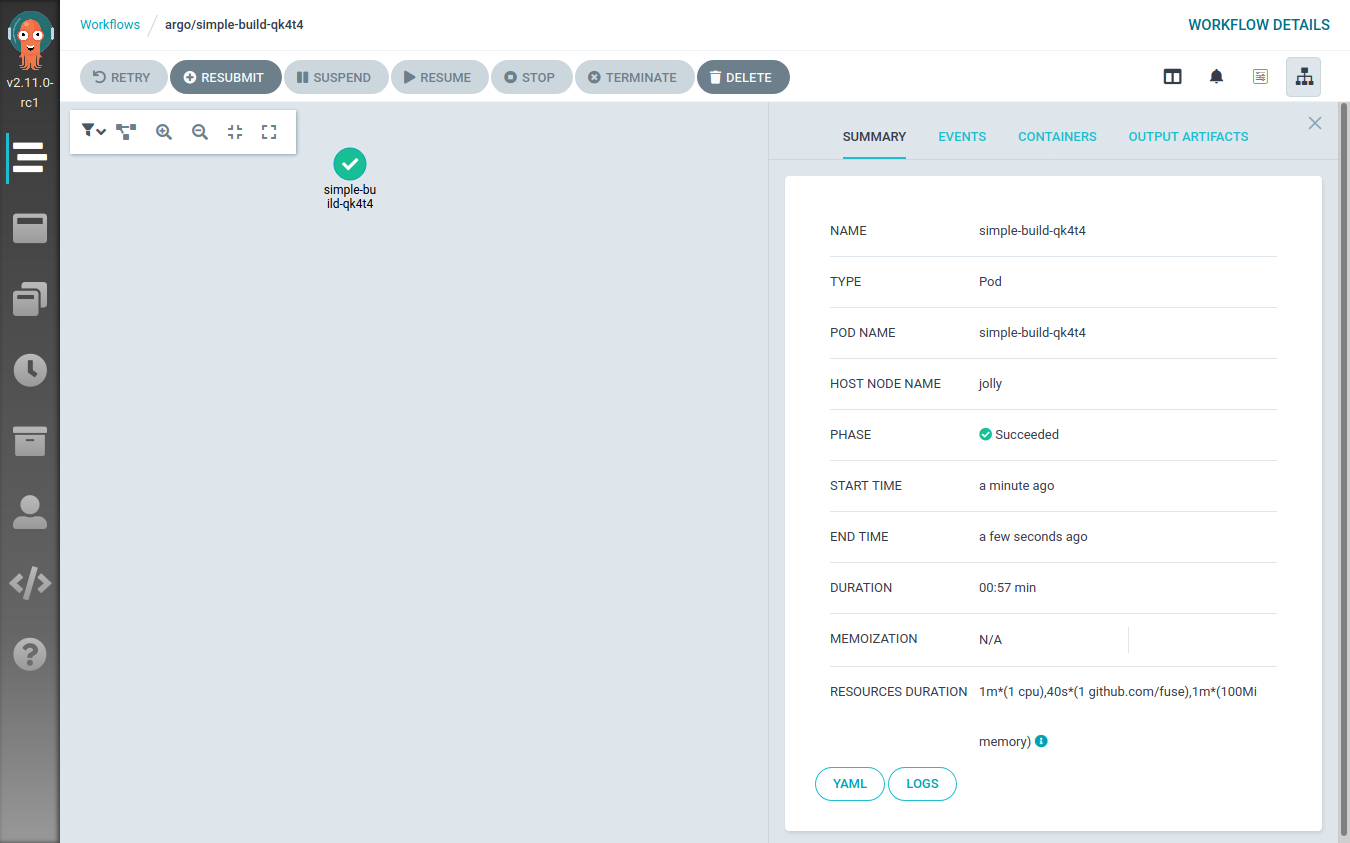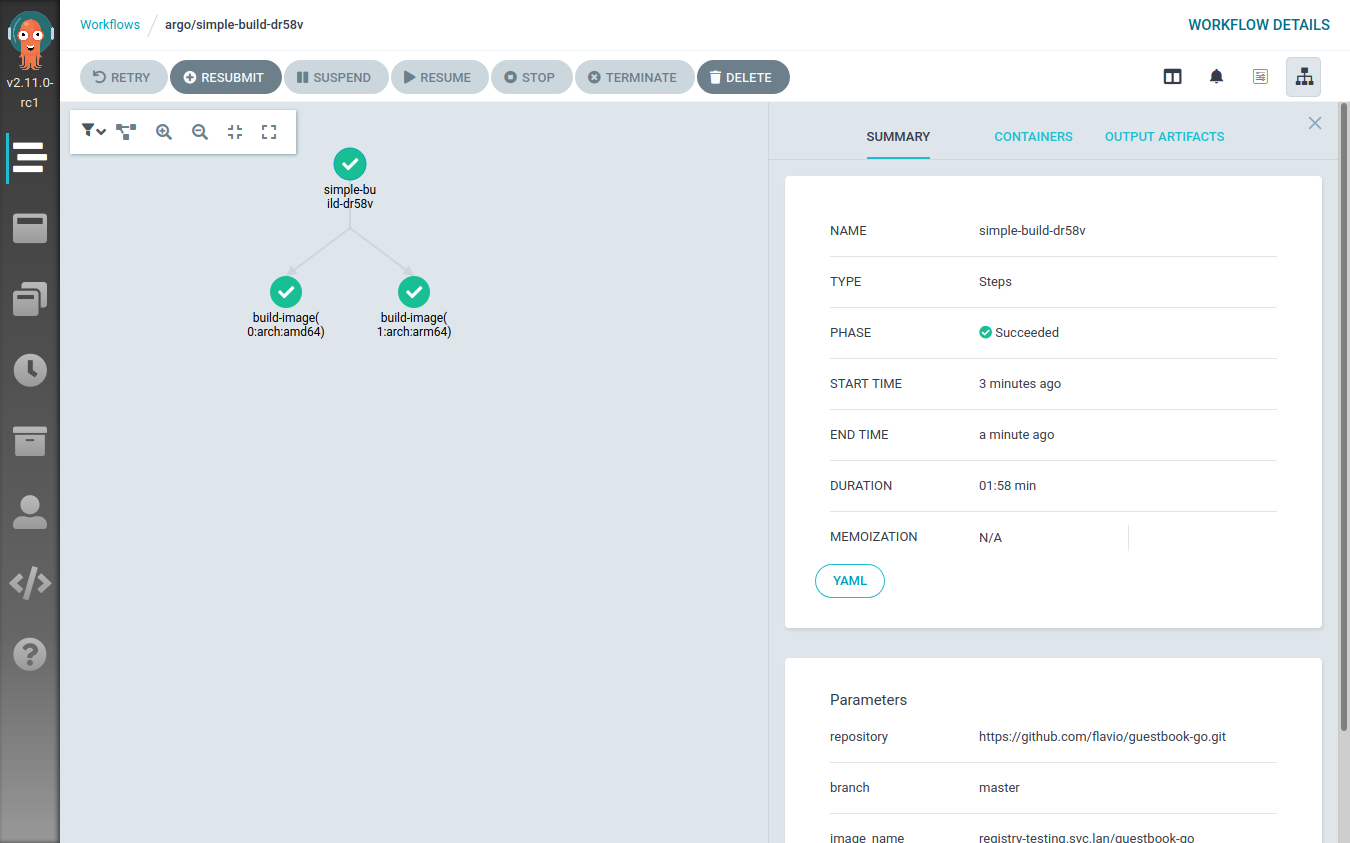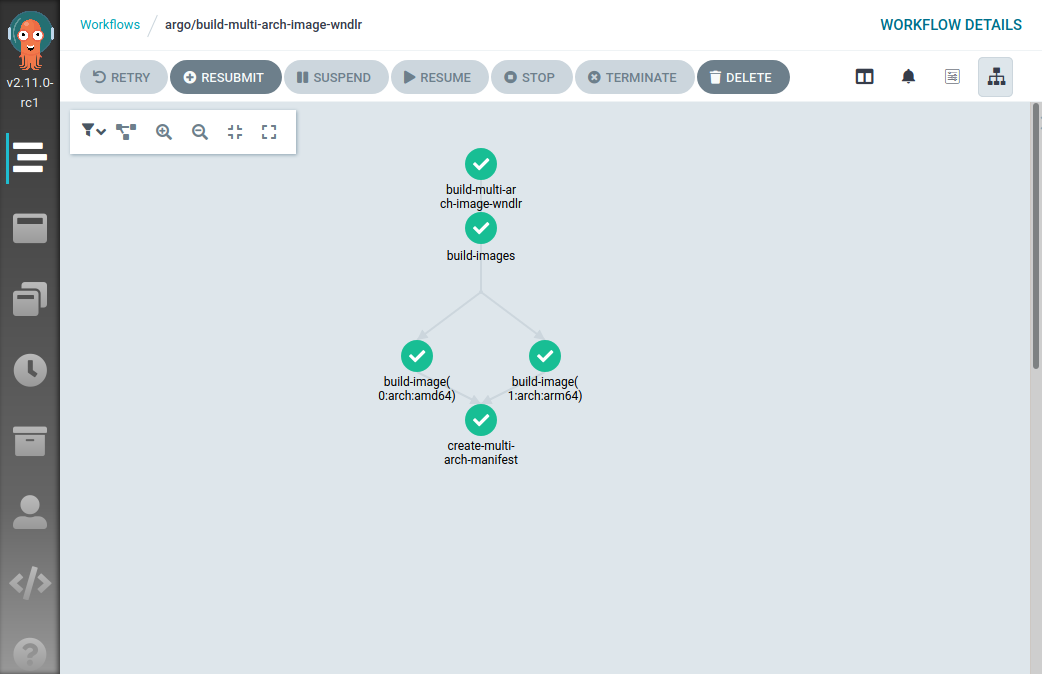Note well: this blog post is part of a series, checkout the previous episode about running containerized buildah on top of Kubernetes.
Quick recap
I have a small Kubernetes cluster running at home that is made of ARM64 and x86_64 nodes. I want to build multi-architecture images so that I can run them everywhere on the cluster, regardless of the node architecture. My plan is to leverage the same cluster to build these container images. That leads to a “Inception-style” scenario: building container images from within a container itself.
To achieve that I decided to rely on buildah to build the container images. I’ve shown how run buildah in a containerized fashion without using a privileged container and with a tailor-made AppArmor profile to secure it.
The previous blog post also showed the definition of Kubernetes PODs that would build the actual images.
Today’s goals
What I’m going to show today is how to automate the whole building process.
Given the references to the Git repository that provides a container image definition, I want to automate these steps:
- Build the container image on a ARM64 node, push the image to a container registry.
- Build the container image on a x86_64 node, push the image to a container registry.
- Create a multi-architecture container image manifest, push it to a container registry.
Steps #1 and #2 can be done in parallel, while step #3 needs to wait for the previous ones to complete.
This kind of automation can be done using some pipeline solution.
Kubernetes native pipeline solutions
There are many Continuous Integration and Continuous Delivery solutions that are available for Kubernetes. If you love to seek enlightenment by staring in front of beautiful logos, checkout this portion of the CNCF landscape dedicated to CI and CD solutions. 🤯
After some research I came up with two potential candidates: Argo and Tekton.
Both are valid projects with active communities. However I decided to settle on Argo. The main reason that led to this decision was the lack of ARM64 support from Tekton.
Interestingly enough, both Tekton and kaniko (which I discussed in the previous blog post of this series) use the same mechanism to build themselves, a mechanism that can produce only x86_64 container images and is not so easy to extend.
Argo is an umbrella of different projects, each one of them tackling specific problems like:
The projects above are just the mature ones, many others can be found under the Argo project labs GitHub organization. These projects are not yet considered production ready, but are super interesting.
My favourite ones are:
The majority of these projects don’t have ARM64 container images yet, but work is being done and this work is significantly simpler compared to the one of porting Tekton. Most important of all: the core projects I need have already been ported.
Creating pipelines using Argo Workflow
A pipeline can be created inside Argo by defining a Workflow resource.
Copying from the core concepts documentation page of Argo Workflow, these are the elements I’m going to use:
- Workflow: a Kubernetes resource defining the execution of one or more
template. - Template: a
step,stepsordag. - Step: a single step of a workflow, typically runs a container based on inputs and capture the outputs.
- Steps: a list of steps.
- Directed Acyclic Graph (DAG): a set of steps (nodes) and the dependencies (edges) between them.
Spoiler alert, I’m going to create multiple Argo Templates, each one of them focusing on one specific part of the problem. Then I’ll use a DAG to explicit the dependencies between all these Templates. Finally, I’ll define an Argo Workflow to “wrap” all these objects.
I could show you the final result right away, but you would probably be overwhelmed by it. I’ll instead go step-by-step as I did. I’ll start with a small subset of the problem and then I’ll keep building on top of it.
Porting our build POD to an Argo Workflow
By the end of the previous blog post, I was able to build a container image by using the following Kubernetes POD definition:
apiVersion: v1
kind: Pod
metadata:
name: builder
annotations:
container.apparmor.security.beta.kubernetes.io/main: localhost/containerized_buildah
spec:
nodeSelector:
kubernetes.io/arch: "amd64"
containers:
- name: main
image: registry.opensuse.org/home/flavio_castelli/containers/containers/buildahimage:latest
command: ["/bin/sh"]
args: ["-c", "cd code; cd $(readlink checkout); buildah bud -t guestbook ."]
volumeMounts:
- name: code
mountPath: /code
resources:
limits:
github.com/fuse: 1
initContainers:
- name: git-sync
image: k8s.gcr.io/git-sync/git-sync:v3.1.7
args: [
"--one-time",
"--depth", "1",
"--dest", "checkout",
"--repo", "https://github.com/flavio/guestbook-go.git",
"--branch", "master"]
volumeMounts:
- name: code
mountPath: /tmp/git
volumes:
- name: code
emptyDir:
medium: MemoryThese are the key points of this POD:
- It uses an Init Container to retrieve the source code of the container image from a Git repository.
- A Kubernetes Volume is used to share the source code of the container image to be built between the Init Container and the main one.
- The Git repository details, the image name and other references are all hard-coded.
- The POD just builds the container image, there’s no push action at the end of it.
- The POD is forcefully scheduled on a x86_64 node; hence this will produce only x86_64 container images.
- The POD requires a Fuse resource, this is required to allow buildah to use the performant overlay graph driver.
- The POD uses a specific AppArmor profile, not the default one provided by the container engine.
Starting from something like Argo’s “Hello world Workflow”, we can transpose the POD defined above to something like that:
apiVersion: argoproj.io/v1alpha1
kind: Workflow
metadata:
generateName: simple-build-
spec:
entrypoint: buildah
templates:
- name: buildah
metadata:
annotations:
container.apparmor.security.beta.kubernetes.io/main: localhost/containerized_buildah
nodeSelector:
kubernetes.io/arch: "amd64"
container:
image: registry.opensuse.org/home/flavio_castelli/containers/containers/buildahimage:latest
command: ["/bin/sh"]
args: ["-c", "cd code; cd $(readlink checkout); buildah bud -t guestbook ."]
volumeMounts:
- name: code
mountPath: /code
resources:
limits:
github.com/fuse: 1
initContainers:
- name: git-sync
image: k8s.gcr.io/git-sync/git-sync:v3.1.7
args: [
"--one-time",
"--depth", "1",
"--dest", "checkout",
"--repo", "https://github.com/flavio/guestbook-go.git",
"--branch", "master"]
volumeMounts:
- name: code
mountPath: /tmp/git
volumes:
- name: code
emptyDir:
medium: MemoryAs you can see the POD definition has been transformed into a Template
object. The contents of the POD spec section have been basically copied and pasted under the Template.
The POD annotations have been moved straight under the template.metadata section.
I have to admit this was pretty confusing to me in the beginning, but everything became clear once I started to look at the field documentation of the Argo resources.
The workflow can be submitted using the argo cli tool:
$ argo submit workflow-simple-build.yaml
Name: simple-build-qk4t4
Namespace: argo
ServiceAccount: default
Status: Pending
Created: Wed Sep 30 15:45:20 +0200 (now)This will be visible also from the Argo Workflow UI:

Refactoring the Argo Workflow
The previous Workflow definition can be cleaned up a bit, leading to the following YAML file:
apiVersion: argoproj.io/v1alpha1
kind: Workflow
metadata:
generateName: simple-build-
spec:
entrypoint: buildah
templates:
- name: buildah
inputs:
parameters:
- name: arch
- name: repository
- name: branch
- name: image_name
- name: image_tag
metadata:
annotations:
container.apparmor.security.beta.kubernetes.io/main: localhost/containerized_buildah
nodeSelector:
kubernetes.io/arch: "amd64"
script:
image: registry.opensuse.org/home/flavio_castelli/containers/containers/buildahimage:latest
command: [bash]
source: |
set -xe
cd /code/
# needed to workaround protected_symlink - we can't just cd into /code/checkout
cd $(readlink checkout)
buildah bud -t {{inputs.parameters.image_name}}:{{inputs.parameters.image_tag}}-{{inputs.parameters.arch}} .
buildah push --cert-dir /certs {{inputs.parameters.image_name}}:{{inputs.parameters.image_tag}}-{{inputs.parameters.arch}}
echo Image built and pushed to remote registry
volumeMounts:
- name: code
mountPath: /code
- name: certs
mountPath: /certs
readOnly: true
resources:
limits:
github.com/fuse: 1
initContainers:
- name: git-sync
image: k8s.gcr.io/git-sync/git-sync:v3.1.7
args: [
"--one-time",
"--depth", "1",
"--dest", "checkout",
"--repo", "{{inputs.parameters.repository}}",
"--branch", "{{inputs.parameters.branch}}"]
volumeMounts:
- name: code
mountPath: /tmp/git
volumes:
- name: code
emptyDir:
medium: Memory
- name: certs
secret:
secretName: registry-certCompared to the previous definition, this one doesn’t have any hard-coded
value inside of it. The details of the Git repository, the image name, the container registry,… all
of that is now passed dynamically to the template by using the input.parameters map.
The main container has also been rewritten to use an Argo Workflow specific field: script.source. This
is really handy because it provides a nice way to write a bash script to be executed inside the
container.
The source script has been also extended to perform a push operation at the
end of the build process.
As you can see the architecture of the image is appended to the tag of the image.
This is a common pattern used when building multi-architecture container images.
One final note about the push operation. The destination registry is secured
using a self-signed certificate. Because of that either the CA that signed the
certificate or the registry’s certificate have to be provided to buildah.
This can be done by using the --cert-dir flag and by placing the certificates
to be loaded under the specified path.
Note well, the certificate files must have the .crt file extension otherwise
they won’t be handled.
I “loaded” the certificate into Kubernetes by using a Kubernetes secret like this one:
apiVersion: v1
kind: Secret
metadata:
name: registry-cert
namespace: argo
type: Opaque
data:
ca.crt: `base64 -w 0 actualcert.crt`As you can see the main container is now mounting the contents of the registry-cert
Kubernetes Secret under /certs.
This time, when submitting the workflow, we must specify its parameters:
$ argo submit workflow-simple-build-2.yaml \
-p arch=amd64 \
-p repository=https://github.com/flavio/guestbook-go.git \
-p branch=master \
-p image_name=registry-testing.svc.lan/guestbook-go \
-p image_tag=0.0.1
Name: simple-build-npqdw
Namespace: argo
ServiceAccount: default
Status: Pending
Created: Wed Sep 30 15:52:06 +0200 (now)
Parameters:
arch: {1 0 amd64}
repository: {1 0 https://github.com/flavio/guestbook-go.git}
branch: {1 0 master}
image_name: {1 0 registry-testing.svc.lan/guestbook-go}
image_tag: {1 0 0.0.1}Building on multiple architectures
The Workflow object defined so far is still hard-coded to be scheduled only
on x86_64 nodes (see the nodeSelector constraint).
I could create a new Workflow definition by copying one shown before and then
change the nodeSelector constraint to reference the
ARM64 architecture. However, this would violate the
DRY principle.
Instead, I will abstract the Workflow definition by leveraging a feature of
Argo Workflow called
loops.
I will define a parameter for the target architecture and then I will iterate
over two possible values: amd64 and arm64.
This is the resulting Workflow definition:
apiVersion: argoproj.io/v1alpha1
kind: Workflow
metadata:
generateName: simple-build-
spec:
entrypoint: build-images-arch-loop
templates:
- name: build-images-arch-loop
inputs:
parameters:
- name: repository
- name: branch
- name: image_name
- name: image_tag
steps:
- - name: build-image
template: buildah
arguments:
parameters:
- name: arch
value: "{{item.arch}}"
- name: repository
value: "{{inputs.parameters.repository}}"
- name: branch
value: "{{inputs.parameters.branch}}"
- name: image_name
value: "{{inputs.parameters.image_name}}"
- name: image_tag
value: "{{inputs.parameters.image_tag}}"
withItems:
- { arch: 'amd64' }
- { arch: 'arm64' }
- name: buildah
inputs:
parameters:
- name: arch
- name: repository
- name: branch
- name: image_name
- name: image_tag
metadata:
annotations:
container.apparmor.security.beta.kubernetes.io/main: localhost/containerized_buildah
nodeSelector:
kubernetes.io/arch: "{{inputs.parameters.arch}}"
script:
image: registry.opensuse.org/home/flavio_castelli/containers/containers/buildahimage:latest
command: [bash]
source: |
set -xe
cd /code/
# needed to workaround protected_symlink - we can't just cd into /code/checkout
cd $(readlink checkout)
buildah bud -t {{inputs.parameters.image_name}}:{{inputs.parameters.image_tag}}-{{inputs.parameters.arch}} .
buildah push --cert-dir /certs {{inputs.parameters.image_name}}:{{inputs.parameters.image_tag}}-{{inputs.parameters.arch}}
echo Image built and pushed to remote registry
volumeMounts:
- name: code
mountPath: /code
- name: certs
mountPath: /certs
readOnly: true
resources:
limits:
github.com/fuse: 1
initContainers:
- name: git-sync
image: k8s.gcr.io/git-sync/git-sync:v3.1.7
args: [
"--one-time",
"--depth", "1",
"--dest", "checkout",
"--repo", "{{inputs.parameters.repository}}",
"--branch", "{{inputs.parameters.branch}}"]
volumeMounts:
- name: code
mountPath: /tmp/git
volumes:
- name: code
emptyDir:
medium: Memory
- name: certs
secret:
secretName: registry-certThe workflow definition grew a bit. I’ve added a new template called build-images-arch-loop, which is now
the entry point of the workflow. This template performs a loop over the
[ { arch: 'amd64' }, { arch: 'arm64' } ] array, each time invoking the buildah
template with slightly different input parameters. The only parameter that changes
across the invocations is the arch one, which is used to define the
nodeSelector constraint.
Executing this workflow results in two steps being executed at the same time: one building the image on a random x86_64 node, the other doing the same thing on a random ARM64 node.
This can be clearly seen from the Argo Workflow UI:

When the workflow execution is over, the registry will contain two different images:
<image-name>:<image-tag>-amd64<image-name>:<image-tag>-arm64
Now there’s just one last step to perform: create a multi-architecture container manifest referencing these two images.
Creating the image manifest
The Image manifest Version 2, Schema 2
specification defines a new type of image manifest called “Manifest list”
(application/vnd.docker.distribution.manifest.list.v2+json).
Quoting the official specification:
The manifest list is the “fat manifest” which points to specific image manifests for one or more platforms. Its use is optional, and relatively few images will use one of these manifests. A client will distinguish a manifest list from an image manifest based on the Content-Type returned in the HTTP response.
The creation of such a manifest is pretty easy and it can be done with docker, podman and buildah in a similar way.
I will still use buildah to create the manifest and push it to the registry where all the images are stored.
This is the Argo Template that takes care of that:
- name: create-manifest
inputs:
parameters:
- name: image_name
- name: image_tag
- name: architectures
metadata:
annotations:
container.apparmor.security.beta.kubernetes.io/main: localhost/containerized_buildah
volumes:
- name: certs
secret:
secretName: registry-cert
script:
image: registry.opensuse.org/home/flavio_castelli/containers/containers/buildahimage:latest
command: [bash]
source: |
set -xe
image_name="{{inputs.parameters.image_name}}"
image_tag="{{inputs.parameters.image_tag}}"
architectures="{{inputs.parameters.architectures}}"
target="${image_name}:${image_tag}"
architectures_list=($(echo $architectures | tr "," "\n"))
buildah manifest create ${target}
#Print the split string
for arch in "${architectures_list[@]}"
do
arch_image="${image_name}:${image_tag}-${arch}"
buildah pull --cert-dir /certs ${arch_image}
buildah manifest add ${target} ${arch_image}
done
buildah manifest push --cert-dir /certs ${target} docker://${target}
echo Manifest creation done
volumeMounts:
- name: certs
mountPath: /certs
readOnly: true
resources:
limits:
github.com/fuse: 1The template has an input parameter called architectures, this string is made
of the architectures names joined by a comma; e.g. "amd64,arm64".
The script creates a manifest with the name of the image and then, iterating
over the architectures, it adds the architecture-specific images to it.
Once this is done the manifest is pushed to the container registry.
To make a simple example, assuming the following scenario:
- We are building the
guestbook-goapplication with releasev0.1.0 - We want to build the image for the x86_64 and the ARM64 architectures
- We want to push the images to the
registry.svc.lanregistry
The Argo Template that creates the manifest will pull the following images:
registry.svc.lan/guestbook-go:v0.1.0-amd64: the x86_64 imageregistry.svc.lan/guestbook-go:v0.1.0-arm64: the ARM64 image
Finally, the Template will create and push a manifest named registry.svc.lan/guestbook-go:v0.1.0.
This image reference will always return the right container image to the node
requesting it.
Adding the container image to the manifest is done with the
buildah manifest add command. This command doesn’t actually need to have
the container image available locally, it would be enough to reach out to
the registry hosting it to obtain the manifest digest.
In our case the images are stored on a registry secured with
a custom certificate. Unfortunately, the manifest add command
was lacking some flags (like the cert one); because of that I had
to introduce the workaround of pre-pulling all the images referenced
by the manifest. This has the side effect of wasting some time, bandwidth and
disk space.
I’ve submitted patches both to buildah
and to podman to enrich their
manifest add commands; both pull requests have been merged into the master
branches. The next release of buildah will ship with my patch and the
manifest creation Template will be simpler and faster.
Explicating dependencies between Argo templates
Argo allows to define a workflow sequence with clear dependencies between each step. This is done by defining a DAG.
Our workflow will be made of one Argo Template of type DAG, that will have two tasks:
- Build the multi-architecture images. This is done with the Argo Workflow loop shown above.
- Create the manifest. This task depends on the successful completion of the previous one.
This is the Template definition:
- name: full-process
dag:
tasks:
- name: build-images
template: build-images-arch-loop
arguments:
parameters:
- name: repository
value: "{{workflow.parameters.repository}}"
- name: branch
value: "{{workflow.parameters.branch}}"
- name: image_name
value: "{{workflow.parameters.image_name}}"
- name: image_tag
value: "{{workflow.parameters.image_tag}}"
- name: create-multi-arch-manifest
dependencies: [build-images]
template: create-manifest
arguments:
parameters:
- name: image_name
value: "{{workflow.parameters.image_name}}"
- name: image_tag
value: "{{workflow.parameters.image_tag}}"
- name: architectures
value: "{{workflow.parameters.architectures_string}}"As you can see the Template takes the usual series of parameters we’ve already defined, and forwards them to the tasks.
This is the full definition of our Argo workflow, hold on… this is really long 🙀
apiVersion: argoproj.io/v1alpha1
kind: Workflow
metadata:
generateName: build-multi-arch-image-
spec:
ttlStrategy:
secondsAfterCompletion: 60
entrypoint: full-process
arguments:
parameters:
- name: repository
value: https://github.com/flavio/guestbook-go.git
- name: branch
value: master
- name: image_name
value: registry-testing.svc.lan/guestbook
- name: image_tag
value: 0.0.1
- name: architectures_string
value: "arm64,amd64"
templates:
- name: full-process
dag:
tasks:
- name: build-images
template: build-images-arch-loop
arguments:
parameters:
- name: repository
value: "{{workflow.parameters.repository}}"
- name: branch
value: "{{workflow.parameters.branch}}"
- name: image_name
value: "{{workflow.parameters.image_name}}"
- name: image_tag
value: "{{workflow.parameters.image_tag}}"
- name: create-multi-arch-manifest
dependencies: [build-images]
template: create-manifest
arguments:
parameters:
- name: image_name
value: "{{workflow.parameters.image_name}}"
- name: image_tag
value: "{{workflow.parameters.image_tag}}"
- name: architectures
value: "{{workflow.parameters.architectures_string}}"
- name: build-images-arch-loop
inputs:
parameters:
- name: repository
- name: branch
- name: image_name
- name: image_tag
steps:
- - name: build-image
template: buildah
arguments:
parameters:
- name: arch
value: "{{item.arch}}"
- name: repository
value: "{{inputs.parameters.repository}}"
- name: branch
value: "{{inputs.parameters.branch}}"
- name: image_name
value: "{{inputs.parameters.image_name}}"
- name: image_tag
value: "{{inputs.parameters.image_tag}}"
withItems:
- { arch: 'amd64' }
- { arch: 'arm64' }
- name: buildah
inputs:
parameters:
- name: arch
- name: repository
- name: branch
- name: image_name
- name: image_tag
metadata:
annotations:
container.apparmor.security.beta.kubernetes.io/main: localhost/containerized_buildah
nodeSelector:
kubernetes.io/arch: "{{inputs.parameters.arch}}"
volumes:
- name: code
emptyDir:
medium: Memory
- name: certs
secret:
secretName: registry-cert
script:
image: registry.opensuse.org/home/flavio_castelli/containers/containers/buildahimage:latest
command: [bash]
source: |
set -xe
cd /code/
# needed to workaround protected_symlink - we can't just cd into /code/checkout
cd $(readlink checkout)
buildah bud -t {{inputs.parameters.image_name}}:{{inputs.parameters.image_tag}}-{{inputs.parameters.arch}} .
buildah push --cert-dir /certs {{inputs.parameters.image_name}}:{{inputs.parameters.image_tag}}-{{inputs.parameters.arch}}
echo Image built and pushed to remote registry
volumeMounts:
- name: code
mountPath: /code
- name: certs
mountPath: /certs
readOnly: true
resources:
limits:
github.com/fuse: 1
initContainers:
- name: git-sync
image: k8s.gcr.io/git-sync/git-sync:v3.1.7
args: [
"--one-time",
"--depth", "1",
"--dest", "checkout",
"--repo", "{{inputs.parameters.repository}}",
"--branch", "{{inputs.parameters.branch}}"]
volumeMounts:
- name: code
mountPath: /tmp/git
- name: create-manifest
inputs:
parameters:
- name: image_name
- name: image_tag
- name: architectures
metadata:
annotations:
container.apparmor.security.beta.kubernetes.io/main: localhost/containerized_buildah
volumes:
- name: certs
secret:
secretName: registry-cert
script:
image: registry.opensuse.org/home/flavio_castelli/containers/containers/buildahimage:latest
command: [bash]
source: |
set -xe
image_name="{{inputs.parameters.image_name}}"
image_tag="{{inputs.parameters.image_tag}}"
architectures="{{inputs.parameters.architectures}}"
target="${image_name}:${image_tag}"
architectures_list=($(echo $architectures | tr "," "\n"))
buildah manifest create ${target}
#Print the split string
for arch in "${architectures_list[@]}"
do
arch_image="${image_name}:${image_tag}-${arch}"
buildah pull --cert-dir /certs ${arch_image}
buildah manifest add ${target} ${arch_image}
done
buildah manifest push --cert-dir /certs ${target} docker://${target}
echo Manifest creation done
volumeMounts:
- name: certs
mountPath: /certs
readOnly: true
resources:
limits:
github.com/fuse: 1That’s how life goes with Kubernetes, sometimes there’s just a lot of YAML…

Now we can submit the workflow to Argo:
$ argo submit build-pipeline-final.yml
Name: build-multi-arch-image-wndlr
Namespace: argo
ServiceAccount: default
Status: Pending
Created: Thu Oct 01 16:22:46 +0200 (now)
Parameters:
repository: {1 0 https://github.com/flavio/guestbook-go.git}
branch: {1 0 master}
image_name: {1 0 registry-testing.svc.lan/guestbook}
image_tag: {1 0 0.0.1}
architectures_string: {1 0 arm64,amd64}The visual representation of the workflow is pretty nice:

As you might have noticed, I didn’t provide any parameter to argo submit; the
Argo Workflow now has default values for all the input parameters.
Garbage collector
Something worth of note, Argo Workflow leaves behind all the containers it creates. This is good to triage failures, but I don’t want to clutter my cluster with all these resources.
Argo provides cost optimization parameters to implement cleanup strategies. The one I’ve used above is the Workflow TTL Strategy.
You can see these lines at the top of the full Workflow definition:
apiVersion: argoproj.io/v1alpha1
kind: Workflow
metadata:
generateName: build-multi-arch-image-
spec:
ttlStrategy:
secondsAfterCompletion: 60This triggers an automatic cleanup of all the PODs spawned by the Workflow 60 seconds after its completion, be it successful or not.
Summary
Today we have seen how to create a pipeline that builds container images for multiple architectures on top an existing Kubernetes cluster.
Argo Workflow proved to be a good solution for this kind of automation. There’s quite some YAML involved with that, but I highly doubt over projects would have spared us from that.
What can we do next? Well, to me the answer is pretty clear. The definition of the container image is stored inside of a Git repository; hence I want to connect my Argo Workflow to the events happening inside of the Git repository.
Stay tuned for more updates! In the meantime feedback is always welcome.